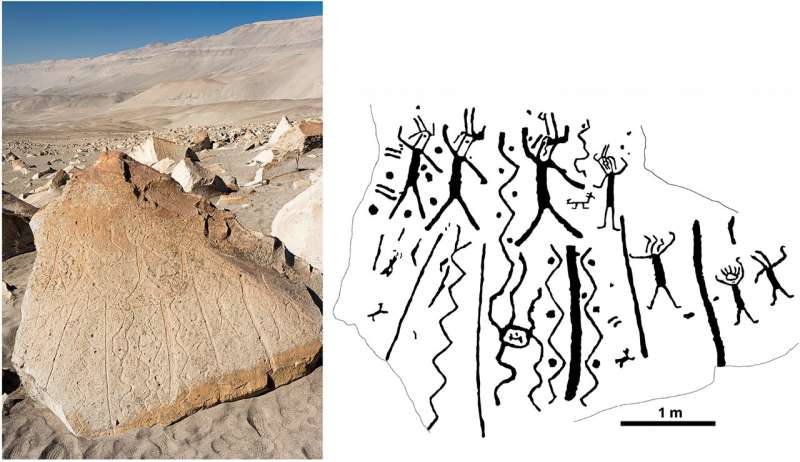April 8, 2024 report
This article has been reviewed according to Science X's editorial process and policies. Editors have highlighted the following attributes while ensuring the content's credibility:
fact-checked
peer-reviewed publication
trusted source
proofread
Carvings in southern Peru may have been inspired by people singing while hallucinating

A pair of archaeologists, one with Adam Mickiewicz University in Poznań, the other with the University of Warsaw, both in Poland, has found evidence suggesting that rock carvings found in a southern part of Peru may have been inspired by people singing while consuming hallucinogenic plants. In their study, published in the Cambridge Archaeological Journal, Andrzej Rozwadowski and Janusz Wołoszyn analyzed rock carvings found in Toro Muerto.
Toro Muerto, ("dead bull" in Spanish) is a rock art complex in South America situated in a desert gorge near the Majes River Valley, spanning 10 km2. It hosts approximately 2,600 volcanic boulders, each adorned with ancient petroglyphs, ranging from small stones with single motifs to massive boulders with multiple images.
The researchers note that despite its notoriety, little study of the petroglyphs has been done. So for their new study, they conducted an analysis of the danzantes—dancing human figures—that appear on most of the boulders.
The researchers suggest that most of the petroglyphs appear to have been thought out or planned prior to carving—their coloring and uniform spacing suggest the artists knew what they were going to do beforehand.
They also note that most of the carvings followed similar themes—most involved danzantes surrounded by zig-zag or squiggly lines, dots or sometimes circles. They suggest the zig-zags were carved to accentuate the energy and movement associated with wild dancing.
The researchers note that the carvings are very much like those done by the Tukano, early people living in what is now Colombia. Prior research has shown that most of those carvings were made during rituals by people consuming ayahuasca, which is made using hallucinogenic vines.
Because of the similarity, the researchers suggest it is likely that the petroglyphs at Toro Muerto were also carved by people consuming hallucinogenic plants. They further suggest the imagery surrounding their dancing figures appears to show people attempting to depict how the music was making them feel while under the influence of a still unknown hallucinogen.
More information: Andrzej Rozwadowski et al, Dances with Zigzags in Toro Muerto, Peru: Geometric Petroglyphs as (Possible) Embodiments of Songs, Cambridge Archaeological Journal (2024). DOI: 10.1017/S0959774324000064
Journal information: Cambridge Archaeological Journal
© 2024 Science X Network





















